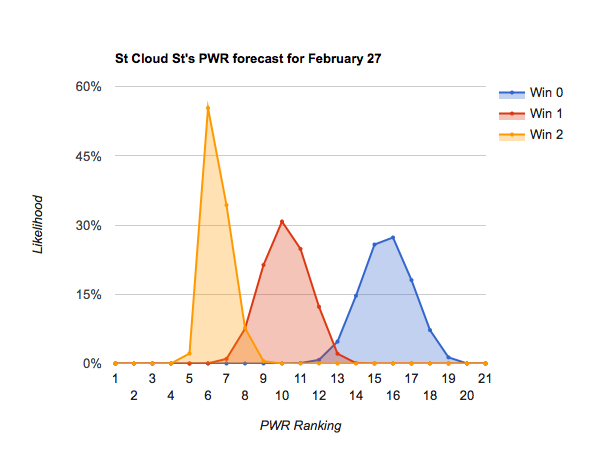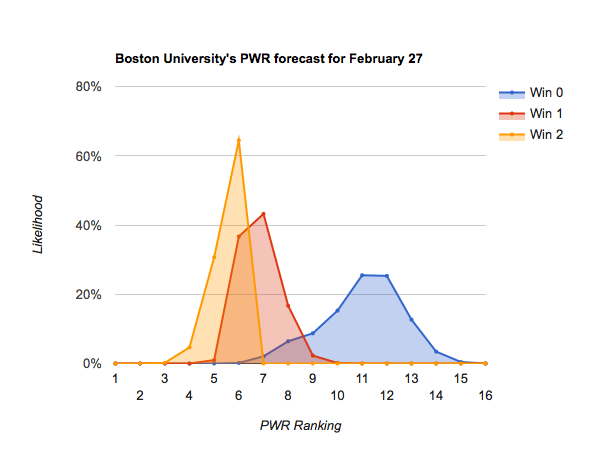If you haven’t read them yet, you might want to start with my articles from earlier this week, Who’s a lock for the NCAA tournament? and Who might fall out of contention for the NCAA tournament? Having visited those two extremes, this article goes into a little more depth on the teams in between.
Background on how PWR matters for tournament selection
Because we get lots of new readers during the tournament season, here’s some background information that my posts generally assume you know:
- The PWR rankings are not a poll or computer model, but are instead an implementation of the same process the NCAA uses to select its tournament participants. They have correctly predicted the NCAA tournament participants for a decade or two.
- Each conference gets to send one tournament winner to the NCAA tournament. So, we don’t need to look at the PWR of a team that wins its conference tournament.
- The remaining 10 slots are given to top teams as ranked by the process implemented in PWR. So, PWR ranks 1-10 are in for sure; but, for 11-16 to make it requires some of the autobids to have gone to teams ranked above them (e.g. if an autobid goes to the team ranked #3, then an extra slot is open for the team ranked #11, and so on).
Because of that structure, we think of teams that are going to finish in the 12-15 range as “on the bubble”. Teams’ prospects are dependent not only on their final ranking, but also on how many lower ranked teams wins conference tournaments. Bubble teams’ chances for an at-large bid increase as slots are freed up by more conference tournaments being won by teams that would have made the NCAA tournament at-large.
A look at the bubble teams
#9 Providence would be on the bubble if eliminated from their conference tournament this weekend. They’d then need a bit of luck to make the NCAA tournament, needing to either climb a bit while idle and/or have a lot of conference tournaments won by top ranked teams.
If Providence wins this weekend, they’ll be in pretty good shape. A semifinal loss would probably push them back down to the high end of the bubble, while a win would nearly lock up a bid.

#10 Boston College is in a very similar position to Providence. They’d be on the bubble if eliminated this weekend and would be watching the other conference tournaments carefully.
If they advance this weekend, they’ll be in pretty good shape — favored, though probably not mathematically secure, for an NCAA bid.

#11 Bowling Green would likely be pushed down below the bubble if eliminated this weekend. It would take a lot of luck to climb back onto the bubble while idle and have most of the conference tournaments won by top ranked teams.
If Bowling Green advances, they would still probably need a semifinal win to stay on the bubble.

#12 Quinnipiac has a chance of staying on the bubble if eliminated this week, but would have to watch future tournament results carefully.
If they advance, another win would probably be needed to stay atop the bubble.

#13 Yale is likely to be pushed just below the bubble if eliminated this weekend, but would stand a slim chance of climbing onto it dependent on other tournament results.
Advancing this weekend would position them well, but not secure a spot in the NCAAs. With an additional win, Yale would be favored to secure a spot.

#14 Minnesota hasn’t entered conference tournament play yet, so does not face elimination. Getting swept this weekend would put them in a bad spot for an at-large bid, but would also probably force them to play in the Big Ten quarterfinals. The extra game would give them the chance to go 2-1 in the conference tournament and possibly get back onto the bubble.

#15 Mass.-Lowell is likely to end well below the bubble if eliminated this weekend. It would take a very unlikely confluence of events for them to move into an at-large bid from that position.
Advancing puts them in a precarious spot on the bubble, such that a subsequent loss would probably push them off.

#16 St Cloud St is currently at 11-12-1 so needs one more win than loss in its remaining games to meet the .500 requirement for consideration for the NCAA tournament. So, the Huskies won’t be considered if eliminated this weekend. If they advance (either 2-1 or 2-0), they’ll be in a decent bubble position, but probably need at least one more win.

#17 Harvard will be below the bubble if eliminated this weekend and it’s very unlikely they could slide into position for an at-large bid while idle.
Advancing would put them right on the bubble, such that they’d probably want another win to stay there.

#18 Colgate is out if eliminated this weekend. Advancing puts them on the low end of the bubble, such that a subsequent loss would probably push them off. Best to advance and win one more.

#19 Vermont is very likely out if eliminated this weekend. Advancing would put them right on the low end of the bubble, such that another win would probably be required to make the tournament at-large.

#20 Michigan is not yet in its conference tournament so is not facing elimination this weekend. Two losses would likely put an at-large bid out of reach, while two wins would bring the bubble within sight. A first round bye, though, would reduce their opportunities to climb in the PWR.

#21 Bemidji State is out if eliminated this weekend. It’s possible, though not particularly likely, that Bemidji State could position itself for an at-large bid by advancing to the conference tournament final and losing.

#22 St. Lawrence is almost identical to Bemidji State. They’re out if they lose this weekend. It’s possible, though not particularly likely, that St. Lawrence could position itself for an at-large bid by advancing to the conference tournament final and losing.

#23 Dartmouth is out if they fail to advance. Dartmouth is better positioned than the teams above it to get an at-large bid by winning a few games then losing the conference final. Winning the conference tournament would be a safer bet.

Methodology
Forecasts include the results of games played through Sunday of this week, unless otherwise noted.
Each forecast is based on at least one million monte carlo simulations of the games in the described period. For each simulation, the PairWise Ranking (PWR) is calculated and the results tallied. The probabilities presented in the forecasts are the share of simulations in which a particular outcome occurred.
The outcome of each game in each simulation is determined by random draw, with the probability of victory for each team set by their relative KRACH ratings. So, if the simulation set included a contest between team A with KRACH 300 and team B with KRACH 100, team A will win the game in very close to 75% of the simulations. I don’t simulate ties or home ice advantage.
Resources






























































